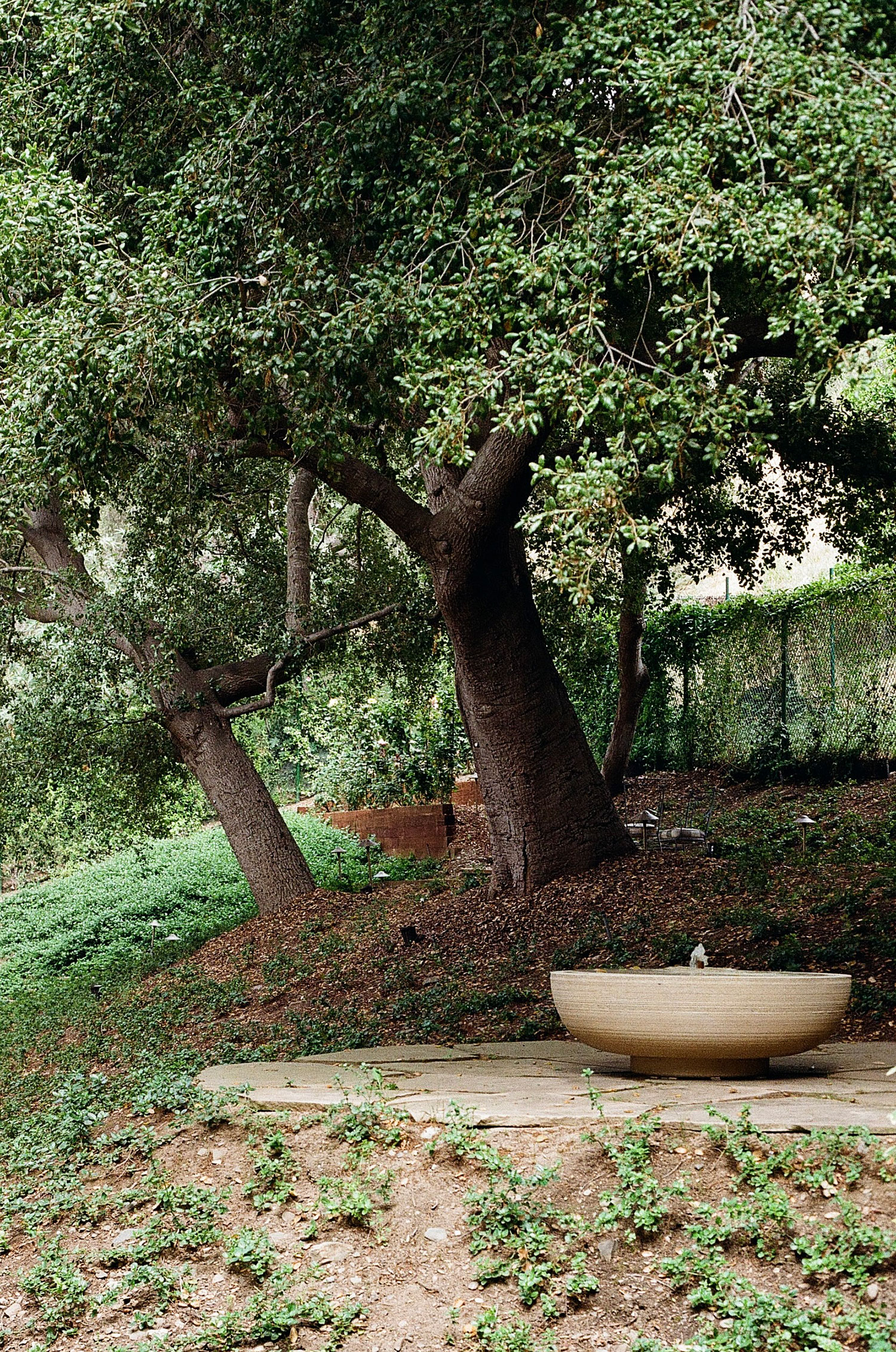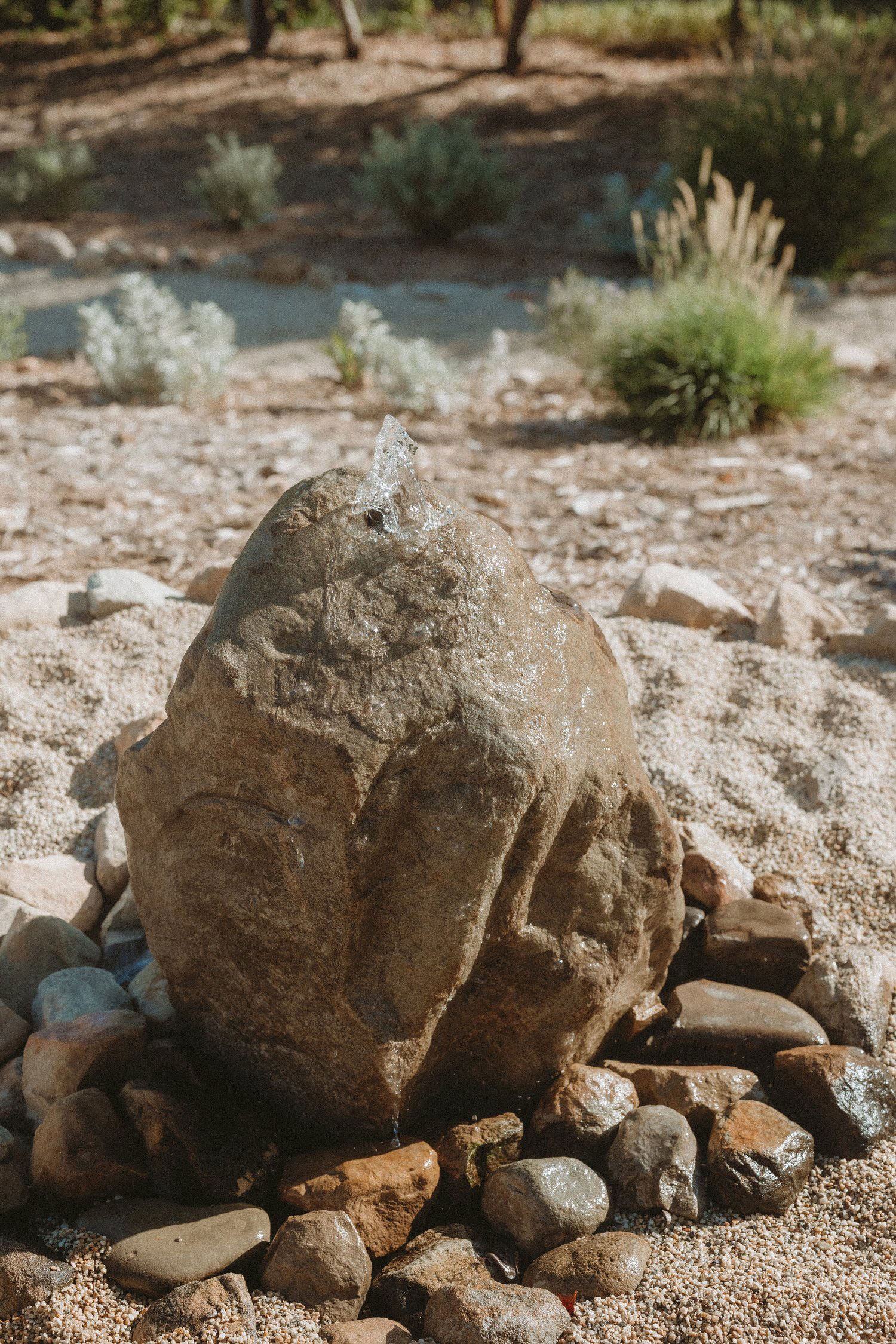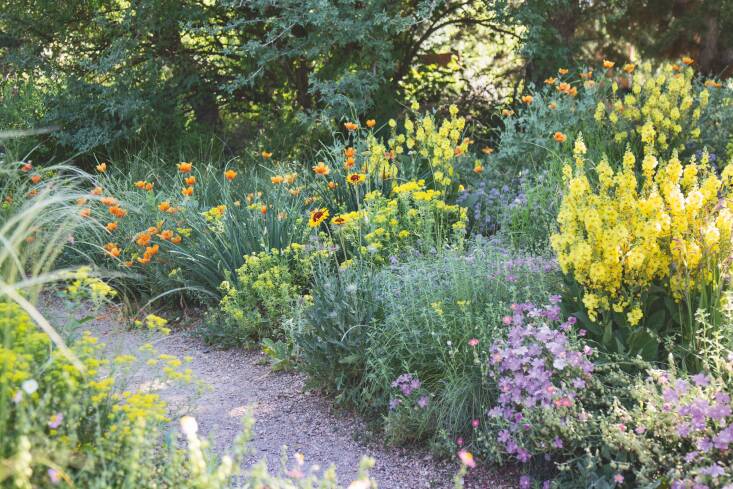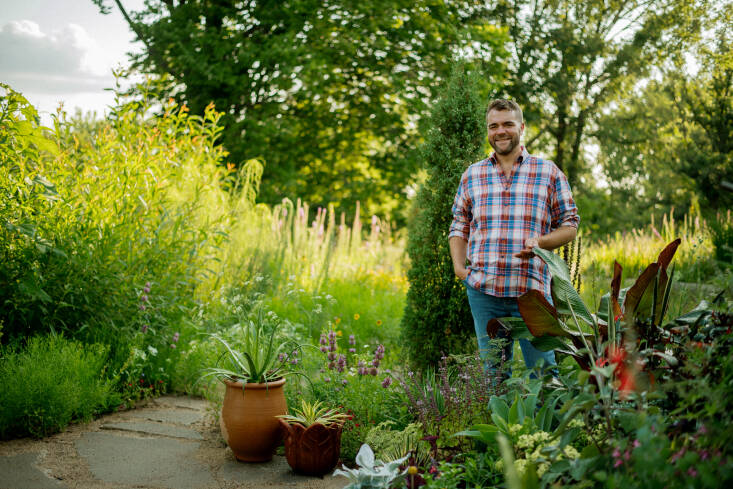When summer temperatures climb across the West, the smartest way to cool down might be right in your own backyard. Whether you’re working with a sprawling landscape or a compact patio, thoughtful design can make your outdoor space feel up to 10 degrees cooler—no misting systems or electric fans required.
We turned to Shannon Porteous, owner and principal designer of Sow Home, a Southern California-based landscape design studio known for crafting low-maintenance, Mediterranean-inspired spaces rooted in California native plants. Her design philosophy centers on creating welcoming, sustainable gardens that feel as good as they look—helping homeowners turn everyday outdoor areas into functional, year-round retreats. Here, she shares seven climate-wise strategies to keep your space breezy, tranquil, and effortlessly stylish—even on the hottest days.
Shannon Porteous/@sow.home
Layer Your Green Space on Multiple Levels
One of the simplest ways to cool down your garden—and elevate its visual appeal—is by thinking beyond the ground plane. Layering vegetation on multiple levels mimics nature’s own insulation system: Tall canopy trees provide shade, mid-level plantings soften reflected heat, and dense groundcovers keep soil cool and moist.
For those in the Western states looking to replicate this effect, Porteous recommends using climate-adapted native plants suited to your region. Her go-to understory picks include Red Flowering Currant (Ribes sanguineum), California Fescue (Festuca californica), Yankee Point Ceanothus (Ceanothus thyrsiflorus var. griseus ‘Yankee Point’), and Hummingbird Sage (Salvia spathacea). For vertical interest, she often turns to vining natives like Island Morning Glory (Calystegia macrostegia), Pink Honeysuckle (Lonicera hispidula), and California Grape (Vitis californica).
Even in small patios or courtyards, Shannon encourages clients to “think vertical.” That might mean adding trellises for climbing plants, using pots atop hardscape to lift greenery into sightlines, or integrating functional accents like rain chains. “Vertical features really maximize your space and make the garden feel larger,” she says—and as a bonus, they provide essential shade and cooling along walls and fences.
Prioritize Shade on the South Side
Not all shade is created equal—especially in the heat-prone regions of the West. “The south-facing side of properties usually gets the most direct sun throughout the day,” says Porteous. “Adding sun-loving shade trees on this side of your garden can create shade where it’s most impactful for cooling things down.”
For maximum payoff with minimal upkeep, Porteous recommends evergreen native trees that thrive in the region and require less water once established. “Coast Live Oak (Quercus agrifolia) and California Bay Laurel (Umbellularia californica) are great options in Southern California,” she says. “They’re low-maintenance and offer excellent year-round shade.”
Of course, selecting the right tree is about more than just canopy size. Porteous always considers how a garden is used before making her final picks. “It all depends on how much space you have and what kind of experience you want,” she explains. “If space is limited and we want to check multiple boxes with one tree, we might choose something edible like citrus or avocado. On the other hand, if year-round shade isn’t essential, we might go with a beautiful deciduous tree like Western Redbud (Cercis occidentalis).”

Shannon Porteous/@sow.home
Mulch It Like You Mean It
Don’t underestimate the cooling power of a well-mulched garden. More than just a finishing touch, mulch is a behind-the-scenes workhorse that can significantly reduce soil temperature while boosting overall garden health. “Mulch is amazing for so many reasons,” says Porteous. “Functionally and ecologically, it helps suppress weeds, keep the soil cool, retain moisture, and reduce evaporation. Not only does it help with saving water, but it also supports overall soil health. I think it’s a win-win!”
In her designs, Porteous often blends function with a sense of place. While organic mulch is a staple for moisture retention and weed control, she also layers in natural elements that reflect the local landscape. “Here in Southern California, I like to incorporate sandstone cobble or boulders—materials you’d find out on a hike nearby,” she says. Cobble can serve as a natural edging, while larger stones might find their place in steps, retaining walls, or dry creek beds.
For a more dynamic, Mediterranean-inspired look, Porteous often combines mulch with drought-tolerant groundcovers like Dymondia, Carex, or creeping thyme. “We use a combination of organic mulch with spreading plants, and also love mulch next to gravel paths,” she explains. The balance depends on the garden’s goals—whether the priority is water retention, visual softness, or defining distinct outdoor zones.

Jess Purple/@wearemattandjess
Add a Soothing Water Element
Even a small water feature can cool your garden and create a peaceful vibe. “I love a water feature of any kind,” says Porteous. “They invite you to slow down and attract birds and pollinators.” For tight spaces, a rain chain replacing a downspout works beautifully. With more room, consider turning a boulder into a fountain, like at one of Porteous’ projects, Casa Vista Hermosa. Limestone troughs, stone fountains, and simple ceramic bowls with recirculating pumps are other stylish, low-maintenance options.
Porteous notes, “Recirculating pumps prevent stagnation and algae, while the moving water draws wildlife.” Placing features low to the ground or adding nearby perches makes them even more inviting. Clients often place water features near kitchen windows to enjoy the soothing sounds and watch birds while cooking. Whether you’re inside or outside, water brings calm and connection—even the family dog will love it.
Invest in Stylish Shade Structures
Shade structures have come a long way—today’s options blend sun protection with sleek design to fit any outdoor style. “There are so many great products on the market now,” says Porteous. “You can customize umbrellas, shade sails, awnings, or pergolas to suit your home’s look while keeping cool.”
Choosing between a permanent pergola and movable umbrellas depends on your space, budget, and lifestyle. Pergolas create a defined outdoor room, perfect for dining or lounging where furniture stays put. Umbrellas, especially adjustable ones, offer flexibility for casual seating or poolside spots.
When it comes to materials, Porteous advises steering clear of cheap synthetics. “Plastic products often don’t hold up and need replacing,” she says. “Natural materials like stone and durable woods—teak, for example—are more of an investment but last longer and age beautifully with care.”

Jess Purple/@wearemattandjess
Design with Airflow in Mind
Good garden design isn’t just about what you plant—it’s also how you arrange it. “At the start, we space plants with their mature size in mind,” explains Porteous. “That prevents overcrowding and ensures air can move freely through the garden.” Plants with movement, like ornamental grasses, can amplify gentle breezes and add soothing rhythm. Regular pruning and removing dead foliage also help keep the space healthy and open to airflow.
Beyond plants, Porteous champions permeable hardscapes such as stepping stones spaced with softscape in between. “These features help keep water onsite and cool the soil,” she says. Adding rain barrels fits right in, storing water sustainably while supporting the garden’s microclimate. Together, these subtle moves create a garden that feels fresher and more comfortable—even on the hottest days.



